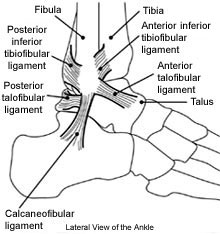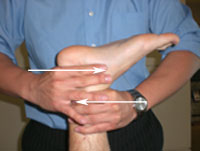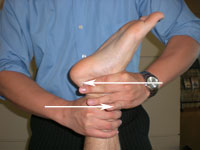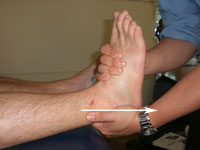|
An ankle injury is quite
commonly treated by a physical therapist. As a result of an injury,
inflammation and tissue damage may occur at the ankle which may restrict
range of motion and result in deficits to strength, stability,
proprioception/somatosensory, flexibility, gait and function. Should
immobilization of the ankle be required, further range of motion limitations
and deficits may occur. If not corrected, this limited range of motion will
disturb normal joint arthrokinematics and could affect a patient’s
performance (1).

The lower
leg/ankle/foot is composed of the tibia and fibula along with 26
bones in the foot. The ankle joint (talocrural joint) is shaped like
a mortise and consists of a bony fit between the talus and the tibia
proximally and medially and the talus and the fibula laterally (2).
The distal tibia and fibula are concave and sit on top of the convex
talus.
The ankle joint is a synovial hinge joint with a joint capsule and
associated ligaments, and is generally considered to have a single
oblique axis with 1° of freedom: dorsiflexion/plantarflexion (3).
(image work of the United States Federal
Government)
Should there be restrictions at the ankle joint as a result of an
injury or immobilization, accessory joint mobilization techniques
can be utilized to assist with restoring normal ankle/foot
arthrokinematics. In a study conducted by Green et al (4), they
found that treatment which included AP mobilizations for patients
who haves sustained acute ankle inversion ankle sprains resulted in
improved pain-free ankle range of movement in dorsiflexion, as well
as the functional outcome of stride speed.
In a preliminary study conducted by Landrum et al (5), they found
that a single application of Grade III anterior-to-posterior
talocrural joint mobilizations appears to increase ankle
dorsiflexion ROM in a population with dorsiflexion ROM restrictions
resulting from prolonged ankle immobilization.
The study conducted by Olson, V (6) also supports the findings of
other researchers that joint mobilization is important to restoring
function to a hypomobilie joint. In this study Olson immobilized the
right carpal joint of 12 dogs and divided the dogs into a control
group and a treatment group which received mobilization therapy. The
results that he obtained showed that the treatment group
demonstrated improve passive ROM and motion during gait. Human
subjects were not utilized in this study because of the ethics
involved of immobilizing a joint.
|
A review of some ankle mobilization techniques to the ankle joint
can be found below
(please note that there are alternative methods to
performing these mobilizations): |

Posterior-Anterior (PA) On
Talus - Stabilize the Tibia of the Talocrural Joint with one hand and push
Posterior-Anterior on the talus with the other hand.
|
| |

Anterior-Posterior (AP) On Talus - Stabilize the Tibia of the
Talocrural Joint with one hand and push Anterior-Posterior on the
talus with the other hand.
|
| |

Distraction of
the Subtalar Joint - One hand fixates on the talus while the
other hand grasps the calcaneus and applies a pull distally.
|
| |

Inferior
Tibiofibular Joint Anterior-Posterior (AP) - With the patient in
a sidelying position and the ankle supported, an anterior-posterior
mobilization is applied on the inferior tibiofibular joint.
|
| |

Inferior
Tibiofibular Joint Posterior-Anterior (AP) - With the patient in
a sidelying position and the ankle supported, an posterior-anterior
mobilization is applied on the inferior tibiofibular joint.
|
| |

Cephalad Glide
- Utilize ankle eversion to indirectly piston the inferior fibula.
|
| |

Caudad Glide
- Utilize ankle inversion to indirectly piston the fibula.
|
Last revised: June 7, 2009
by Chai Rasavong, MPT, MBA
References
1.
Loudon J, Bell S. The Foot and Ankle: An Overview of Arthrokinematics and
Selected Joint Techniques. Journal of Athletic Training. 1996;31(2):173-178.
2.
Riegger C. Anatomy of the Ankle and Foot. Physical Therapy. 1988;68(12):
1802-1814.
3.
Norkin CC, Levangie PK. (1992). Joint Structures & Function - A
Comprehensive Analysis - Second Edition. Philadelphia, PA: F.A. Davis
Company.
4.
Green T, Refshauge K, et al. A Randomized Controlled Trial of Passive
Accessory Joint Mobilization on Acute Ankle Inversion Sprains. Physical
Therapy. 2002;81(4): 984-994.
5
Landrum E, Kelln B, et al. Immediate Effects of Anterior-to-Posterior
Talocrural Joint Mobilization after Prolonged Ankle Immobilization: A
Preliminary Study. The Journal of Manual and Manipulative Therapy. 16(2):
100-105.
6.
Olson, V. Evaluation of Joint Mobilization Treatment. Physical Therapy.
1987;67(3); 351-356. |














